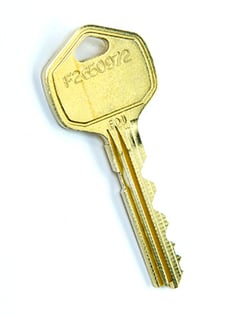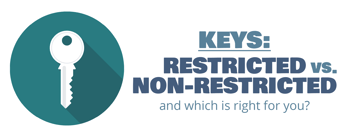4 Security Benefits of a Restricted Key
Maintaining security is a top concern for businesses of all sizes. Creating effective security measures are not only about protecting your property and the assets inside, but regulating who has access, how that access is granted, and limiting possibilities for unauthorized access. When you have multiple buildings to manage and a number of employees with varying levels of required access, it can be challenging to create an effective and secure method of providing entry to employees while adequately safeguarding your properties, assets, and people.
At the root of many organization’s security needs are the ability to limit or eliminate unauthorized access and to keep track of and manage authorized access. There are a number of ways to implement a security system that addresses both of those needs, with varying levels of technological sophistication and cost. A solution to easily address both common security needs is restricted keys.
What is a Restricted Key?

Restricted keys are meant to prevent keys from being copied and shared without authorization and without your knowledge. With restriction, only the provider that controls the keyway can cut additional keys and new key cutting can only be authorized by appropriate personnel. Restricted keys are different from keys you can get at a hardware store stamped “Do Not Duplicate” or “Duplication Prohibited”. Restricted key blanks are tightly controlled and not available on the open market.
Restriction is ideal for businesses with multiple buildings/locations and access points. With hundreds or sometimes even thousands of keys and key holders, it is impossible to know if or when a key is duplicated, creating a security breach opportunity that cannot be prevented through auditing practices, without non-duplicable keys. In some restricted key systems, keys are serialized so each one can be tied to an individual and lock(s) it operates. This provides you with over-arching control of who in your organization has access to what. While you can use these keys for a single lock or location, you’ll get the most security benefits when they are utilized throughout all locks, properties, and locations. This creates a robust key system and gives you a higher level of security. There are four ways in which implementing restricted keys can benefit your organization's security measures.
1. Stronger Overall Security
Preventing unauthorized access to your buildings and property is critical. Restricted keys provide peace of mind knowing that your keys cannot be copied and distributed without your knowledge.
Adding access can be easily managed through your key system provider so that any newly created keys can be tracked and assigned. With serialized keys and record-keeping, a lost or stolen key is easy to deal with when you know exactly what the lost key had access to and which lock(s) needs to be rekeyed to address the security risk. A restricted key system simplifies the process of managing secure access to your locations.
Due to the unique key blanks, restricted keys make it more difficult for associated locks to be picked. And with a keyway that isn’t available in a local hardware store, keys cannot be copied to provide unauthorized access.
2. Better Records
If keys cannot be duplicated, auditing and keeping a record of who has keys becomes more effective because you can be certain about how many keys are in circulation. Serialized or not, each key in a restricted key system is typically stamped with a unique identifier that can be tied to the individual who holds that key and the entry points they have access to. Every time a key is created, it is registered with your designated key provider. The record management for restricted keys depends on the security provider or locksmith who offers the key system, but some offer user-friendly interfaces that make key management easy.
Not only is it easier to track the keys that have been created with a restricted key system, it’s easier to change or remove access when you know exactly who holds each key. Particularly for organizations with a large number of employees with varying levels of access, keeping meticulous records ensures that you have complete control over who has entry.
3.Control Employee Access

Depending on the responsibilities of your employees, certain positions will need different levels of access. Restricted keys make it easy to establish levels of access and track who has keys for entry to areas requiring higher security. A property manager, or district manager can have a master key that allows total access while an employee who only needs limited access can have a key that unlocks only the areas necessary for their duties. And restricted keys add to the security of more limited-access areas of your property knowing that duplicates cannot be made without your knowledge and authorization.
With restricted keys, it is easy to manage employee access when an individual joins or leaves your organization, as each key can be tracked to an employee and associated lock(s). When someone leaves your organization and returns their keys, you can verify that they are the same keys that were issued, with each key’s unique identifier or serial number, and not have to worry that they may have made copies. At that point, having your locks rekeyed is unnecessary and does not become a budgetary burden. When a new employee joins your organization, you can update your records and transition the same keys to the new employee without having to get new keys cut. A restricted key system is an easy and effective way to control and manage employee access.
4. Easily Manage Keys and Lock Changes
The larger your organization is, the more keys you will have. With more keys, the likelihood of them being lost, stolen, or unaccounted for is higher. Restricted keys make it easy to know exactly which entry points need to have locks changed (or rekeyed) after it is discovered that a key is missing, and to which employees you’ll need to redistribute keys to afterward. Along with simplifying your onboarding and offboarding process for maintaining security with turnover, restricted keys eliminate the uncertainty of adding and removing access thanks to the records that can be effectively kept with every key that is cut.
Implementing a Restricted Key System
While implementing new locks and keys to replace your current system can seem like a hassle, the security and organizational benefits of restricted keys are worth the change. An experienced locksmith or key system vendor can design and implement a restricted key system for your business. Finding the right partner in this process can significantly reduce the hassle.
If you are looking to enhance your organization’s security and key management, our team at InstaKey can help you design, install, and maintain restricted key systems of all sizes. We offer small format interchangeable cores (SFIC), standard conventional, and high security locks for all kinds of applications, along with our patented cloud-based key tracking software to provide easy key system management.




